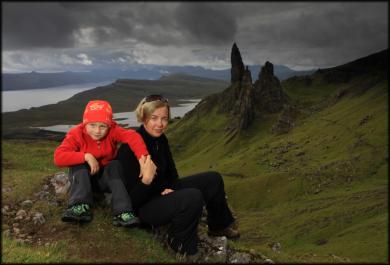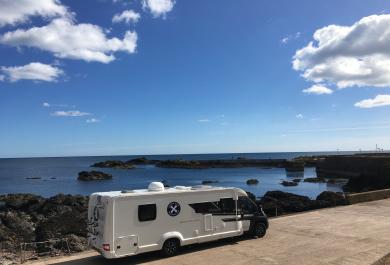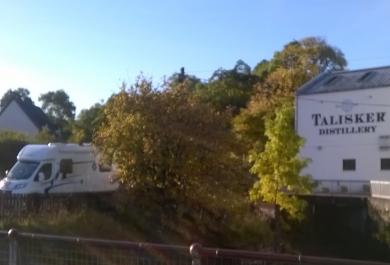
Standing Stones of Scotland Campervan Tour
Scotland is a fascinating and beautiful country and there is something here for everyone. We believe that hiring a campervan allows you to visit spots and places you might not be able to go with the car due to the restriction. With a campervan you have the freedom to explore your hobbies and your interests that little bit further, and still have the comforts of a hotel room.
.png)
In this route planner we explore Standing stones and where they are located so you could look at combing a campervan holiday with a tour of searching out Standing stones which makes for an interesting adventure with the campervan.
Standing stone Facts
Standing Stones are one thing that ensures Scotland stands out from other countries around the world. These standing stones are surrounded by much myth, legend, mystery, religion and history. The stones themselves across Scotland date back to Neolithic times and they can be arranged as single stones, groups, lines or circles. The reasoning behind each different arrangement of standing stones isn’t fully known or understood.
.png)
Archaeologists have spent years in Scotland trying to discovery not only the meaning behind these mysterious stones but also how these huge stones were erected without modern technology. With each stone weighing some 10 tonnes or more transporting them would have been no easy task for the Neolithic people of Scotland. Some have said that the stones have a cosmic influence and that they were placed to see the sun moon and the stars better.
Astrnomical influences
There has been huge research into the astronomical influence on how these stones are located and placed. Alexander Thom spent decades studying these standing stones and the different sites around Scotland’s countryside his theory dates back to 1955. More recently however his findings have been backed up and furthered by a report in 2016. This paper re-evaluates how the standing stones were built. Incredibly they discovered that there were only two different shaped horizons surrounding these beautiful standing stones.
The sun and the moon were placed in very specific patterns within this landscape furthering the theory that the stones are an observatory or a place or worship. The stones appear to show the rising at the highest and the setting at the lowest, one extreme to the other. Worship or to remember the dead within these two extremes appears to have been an influence on the building of these stones. They were a social setting that people would gather round to honour the deceased and possibly even burials and cremations at some sites.
.png)
Where can they be found in Scotland?
This trip will take around 7 – 14 days to complete. For extra places to visit and stay please also see our Hebrides route on our website. https://www.scottishtourer.co.uk/exploring/outer-hebrides-motorhome-route
.png)
Day 1 – Heading to Inverness
After collecting your motorhome head north on the A9 north towards Inverness.
If you’re up for getting out and doing some walking and cycling. Pitlochry is a fantastic place to stop off, just After the Pitlochry turnoff you will find the Clunie road which follows the water’s edge of Loch Faskally.
Priests Stones
If you follow the edge of the Loch you will come across the Priests Stone. The priests stone has a cross carved into both sides and is situated next to the remains of an old chapel beside the road. The Faskally Cottages Stone circle can also be found near here.
This stone circle sits in a garden beside some holiday cottages and is well looked after. There are seven stones in the formation although it is believed there would have been a further two in earlier times to the NE and SW.
.png)
From Pitlochry head north again on the A9 towards Aviemore.
Cairngorms - Aviemore
Heading further up the A9 towards Inverness you will come into the Cairngorms National Park. Here you will find some breath-taking views, magnificent scenery and of course ancient history. Aviemore is around 2 and a half hours from where you collected the campervan in Perth and has an array of activities on offer, making this an ideal overnight stop from cycling to water sports, hill walking or relaxing on the steam train there is something here to amuse everyone.
Aviemore Stones
Here you will come across an unusual site for a stone circle as it’s found in a residential area. The inner circle is almost still completely intact but only 2 stones remain on the outer circle. In 1963 there were reportedly 4 stones while in 1877 there were 7.
Overnight Parking
There are many lovely wild camp spots around here especially by Loch Morlich or up at the Cairngorm ski centre, in the morning you could take the funicular railway and enjoy a bite to eat in the café for breakfast. There is also a wide range of campsites available within Aviemore and the surrounding area.
.png)
Day 2
Once you have explored Aviemore we, drive up the A9 heading and detour towards Nairn and visit Culloden battlefield and the Clava Cairns site before making your way to Ullapool.
Clava Cairns
Clava Cairns which is a 5 minute drive from the Culloden Battlefield which I would highly recommend if you have an interest in Scottish history, and if not it certainly is a worthwhile visit.
Often those who enjoyed Outlander will stop off here to find the film location. The actual name in the film you will not find but you can visit several sites here with standing stones. Be aware that this is a working farm to be respectful of the livestock you may come across.
.png)
Once you have visited Inverness make your way to Ullapool following the A835.
Broomhall Campsite - Ullapool
Once you arrive in Ullapool there is a campsite near the ferry terminal which is a short walk into the town centre, I recommend a to visit the Seafood Shack for dinner – this has been highly recommend by our customers that have visited.
Day 3 The Isle of Lewis in the Outer Hebrides
The ferry will take you from Ullapool to Stirnoway the crossing time is approximately 2.5 hours, once you arrive at Stornoway A857 to Steincleit.
.png)
Steinacleit
On Lewis is Steinacleit this lay well-hidden until the peat was being cleared by crofter in the 1920s and they uncovered a large circular structure and an oval wall enclosure. It was originally thought to be of Neolithic times and along with a circle also a chambered cairn. However, in comparison to similar structures archaeologists believe it may be a prehistoric farm steading, house and yard.
.png)
From here head south on the A858 where you could visit the blackhouse museum or the iron village as you make your way along this costal route to Callanish.
Callanish Stones
These stones are places in a cruciform pattern. Often Christian churches are built to this pattern again relating the standing stones to religion to some degree. The Callanish stones are the largest stone arrangement here but locally you will find at least three other circles, some arcs and single stones. These are mainly all visible from the main site.
.png)
The Callanish site is made up of 13 stones with a monolith near the middle. The central monolith stands at 4.8 metres high, 1.5 metres wide and 0.3 metres thick, the largest sides are almost perfectly orientated to the north and the south. Again, bringing back to the extreme opposites. It weighs roughly 7 tonnes which is a vast amount of stone to move let alone erect.
Overnight Camping
In Uig you will find some fantastic spots to wild camp on the beach front or there is some great campsites if you need to fill up with water or empty the chemical waste, either way you can sit back and relax on the white sandy beaches with a barbeq and a glass of wine.
.png)
Day 4 The Isle Of Harris to North Uist
Once you have explored Lewis head South onto the A859 towards Harris.
.png)
MacLeod Standing Stone
The road from Northern to Southern Harris follows a beautiful 3 mile long beach, it is one of the many stretches you can see here. Here you will find several single standing stones, possibly the best known being the Macloed standing stone which is just before Horgabost.
.png)
There are signs for the standing stone and following a short walk you can appreciate not only the stone but the View you will get of the Island of Taransay. It is located on a grassy slope above a magnificent beach which you will often find is completely empty.
Take in the tranquillity and peace you will find in this remote part of Scotland. You will also find a Neolithic chambered burial cairn in a private garden of a B and B.
From Harris travel to North Uist from Leverburgh, this takes around 2 and a half hours on the ferry. North Uist is the 10th largest Scottish island and is connected by causeways to Bebecula via Grimsay, to Berneray and to Baleshare.
.png)
Piobull Fhinn
The best known and most accessible standing stone circle here is the Piobull Fhinn Stone Circle. It appears to have been situated on a large artificial platform overlooking Loch Langais. It has been dug into the hillside to the rear and built up at the front.
.png)
The ring measure approximately 38 metres x 28 metres with 24 standing stones and boulders still surviving. There is a pair of portal stones forming an entrance at either end of the circle. Beinn a Charra sits on a slope just east of Committee Road in North Uist. The stone is at a considerable angle and about 2 metres off centre, standing at 9’ 3 high and 6’6 wide.
This stone is not perhaps the easiest to reach as it can be very boggy and wet. If you plan to reach the stone here be prepared with goods waterproof clothing and footwear.
Campsites
If you want to stop at a campsite to empty the chemical toilet or top up the fresh water then there is the Balranald campsite situated within the RSPB nature reserve or Moorcroft Campsite which is a family run campsite.
There is also wild camping available, the map below suggests some possible wild camp spots.
.png)
Day 5 South Uist and the Isle of Barra
Moving down to South Uist it is no less picturesque or beautiful. There are two standing stones worth a look at here. When you are in Bornish you are able to walk along the beach to reach the singular stone set here. It is again on a significant angle and is a thin pillar standing at around 1.6meteres tall.
On the coast of the island you will also find another near the Polachar Inn, this is a large stone of 3 metres above the high tide water mark standing at 1.72 metres and 1.5metres wide.
.png)
The island of Barra
The Island of Barra is a remote island found in the Hebrides. The small settlement of Borve is the home to a burial ground. Between the main road and Borve point are the standing stones. Two standing stones used loosely as one is lying down and is slowly being covered by the landscape.
.png)
Campsites
I would recommend Borve campsite or a wildcamp spot near the ferry port for overnight tonight, Borve campsite is only a few miles away from the ferry terminal so its close enough for you to enjoy your last night with a barbeque and your favourite tipple on the beach.
Day 6
From Castleby you can take the ferry to Uig on the Isle of Skye and then you can pick up our Outer Hebridies route from Day 8.
https://www.scottishtourer.co.uk/exploring/outer-hebrides-motorhome-route
If you have only booked a 7-night holiday then you will need to take the ferry on to Oban. In Oban there is a great seafood bar known as the green shack – delicious freshly caught seafood and well worth a visit.
.png)
From Oban take the A85 to Perth this route will take you approximately 3.5 hours in the motorhome, I would recommend staying at a campsite in Crieff, Braidhaugh Holiday Park is only about 30 minute's drive from our depot in Perth and staying in a campsite allows you to empty the chemical waste and tidy the motorhome in preparation for its return in the morning.
These are a small selection of the standing stones sites you could choose to visit or view whilst touring Scotland on your campervan adventure.
The route itself really gives you a beautiful view of Scotland and its rural islands. They really are not to be missed. With their small local communities and produce you will thoroughly enjoy a BBQ outside your motorhome with some of the delicacies on offer.
.png)
The beaches really are worth wild camping at for the peace, tranquillity and sheer beauty. Below is a link to our full Hebrides route which could be combined with the standing stones route which will make for a fantastic Campervan adventure enjoting not only the beauty of the outer hebridie islands but also there history and culture.
.png)
https://www.scottishtourer.co.uk/exploring/outer-hebrides-motorhome-route

Visit Scotland
Working with Visit scotland we have some useful hints and tips to help preserve Scotland's beauty for many years to come.

Walking Tours
http://www.scottshtourer.co.ukWe have picked out 10 Munros which are mountains over 3000 ft high which in our opinion are the easiest to climb and navigate for a beginner.

 Call Us
Call Us Email Us
Email Us Add to Contacts
Add to Contacts Latest Review
Latest Review Book Now
Book Now
